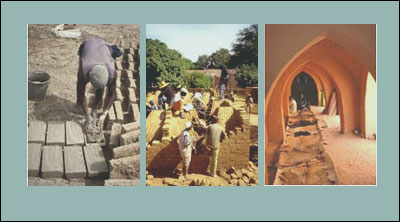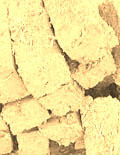
The Sahel thus typifies many other parts of the world facing
similar environmental decline and poverty in Afirca and Latin America, and
in those countries where the problem has already existed for many centuries
(Iran, Egypt, Afghanistan,).
However, the perception of these overall problems is not always the same and
locally concernt about the environment and the disappearance of tree cover
is rarely a priority. There is more concernt about cost and the difficulty
in obtaining materials to build with. Solutions that stand a chance of adoption
have to combine affordability, quality, ease of use and durability.
Amongst the many technical and material options for roofing that could replace
traditional practices few are acceissbile to poor communities because of cost.
Non-local or imported resources are frequently not affordable, whilts cheap
options, such as corrugated roof sheeting, often do not on their own provide
the same climate protection that was achieved with the traditional wood and
earth roof or by thatched roofs.
Woodless construction has therefore aimed to bridge the gap between accessibility
and affordability and quality, and to provide a durable roofing system, using
materials that are locally available, and contributing to a climatically comfortable
built environment.
Introducing new building techniques into the local building vocabulary is
complex and above all a slow process. Several key issues stand out:
- the poorer the community, the less people are prepared to take risks
with unproven
innovation, and it therefore requires time for a ‘product’ to achieve local acceptance. - dealing with the transfer of an established traditional process means
adapting the way
that this has been passed on to new users. In Iran, vault and dome techniques were
passed from father to son, from master builder to apprentice, over a decade or much more. Innovative programmes in a new context require methods allowing much much faster training, measured in weeks and months instead of years. This in turn requires changes to both the technique, and to the method used to teach it, to suit the new context. - a technique cannot be imposed into a new community, but needs to be assimilated. Assimilation of vault and dome roofing shows that it needs to be able to merge and adapt to local styles and local conditions, ranging from the local characteristics of rainfall, to habits about how the home is used, who does maintenance work, or what decorative styles or symbols are important.
The present document deals with the introduction and use of vault and dome roofing built with no supporting formwork,and with hand made unstabilised earth blocks. Woodless Construction is the name that has been given in the Sahel region of West Africa these techniques for the construction of vault or dome roofed buildings using ordinary hand moulded and sun dried mud bricks.
It describes the woodless construction building techniques and the criteria that led to their choice, and to consider the process of how these techniques had been introduced and adapted. The case study underlines that the techniques have to be adapted to very local contexts, and that their is no one standard method that can be applied.
